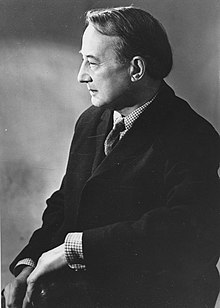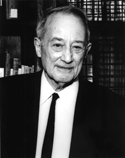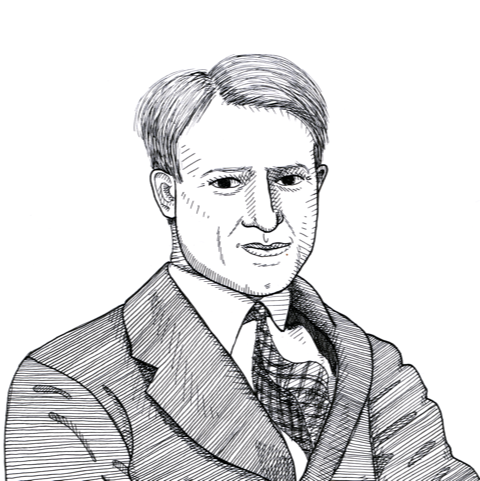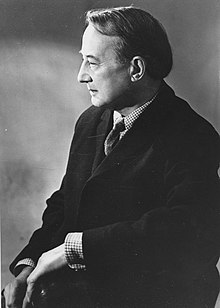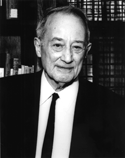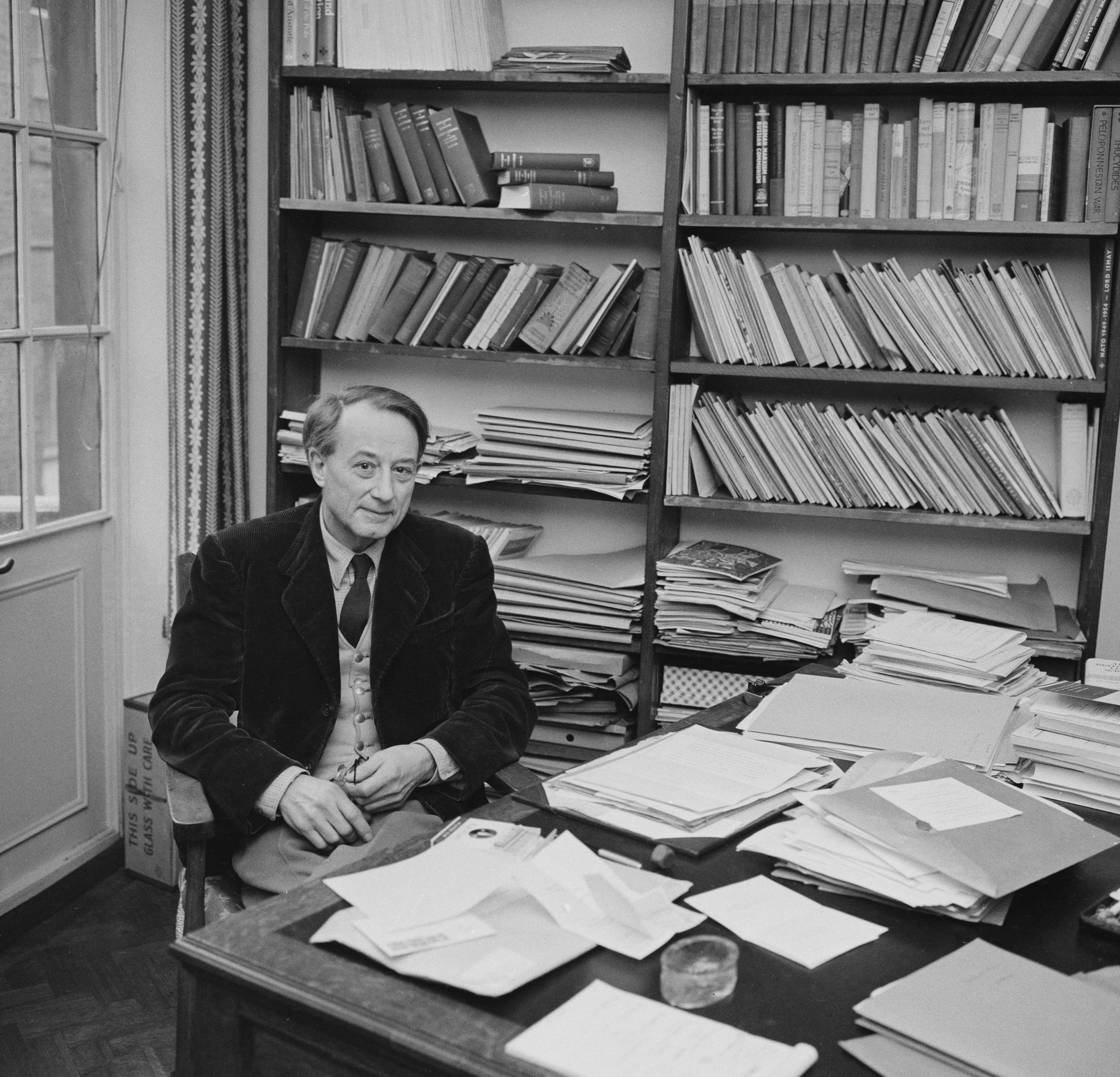Michael Oakeshott was an English political theorist and philosopher who is admired by many conservatives and classical liberals. In this Liberty Matters series, Elizabeth Corey relates Oakeshott's ideal categories of civil and enterprise associations to his ideas about education.
Lead Essay Oakeshott, Liberal Education, and Civil Association
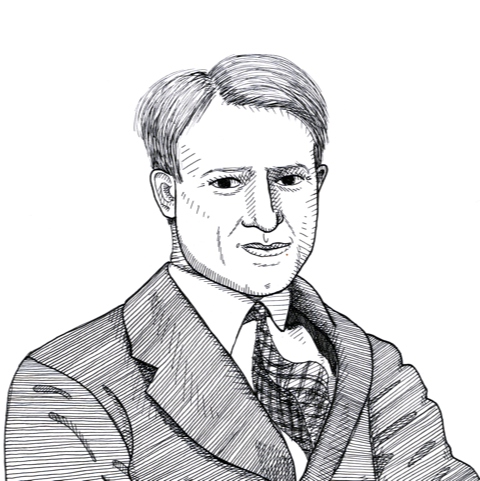
In 1975, Michael Oakeshott wrote On Human Conduct, a major work of political philosophy. In this work he distinguishes two ideal types of human association, which he calls civil and enterprise association. These forms of association represent two distinct ways in which people might live together. In 1989, just before Oakeshott’s death in 1990, Timothy Fuller published a collection of Oakeshott’s essays about liberal education, entitled The Voice of Liberal Learning. These essays set out a vision of liberal learning that is deeply countercultural in our moment.
As far as I know, nobody has related the categories of civil and enterprise association to Oakeshott’s ideas about education, but doing so can help to clarify the character and purpose of universities. Liberal education flourishes when the university is understood as a kind of civil association. Enterprise association, in contrast, tends to tie liberal education to ends that distort its essential character.
To explain the differences briefly: in civil association people are free to choose their own purposes, to explore their individual interests, and to pursue the intimations suggested by their experience. This kind of association requires some basic ground rules, or a rule of law, but does not ask everyone to pursue the same end or set of ends. It is a framework in which students and teachers alike are free to find a “centre for their intellectual affections,” to borrow a phrase from Oakeshott.
Enterprise association, in contrast, requires that associates corporately pursue a substantive purpose. This is the most common mode of human association, and it occurs whenever there is something to be achieved that requires more than one person to do it. We get together to pick up the neighborhood trash; establish a corporation to pursue a business interest; work as a committee of citizens to pass a zoning law; throw a party. The end is clear, the roles of the associates are defined, and the association ends when the goal is attained. The relationship of these people is defined “only by specifying the object, the purpose, or the interest in terms of which they are related,” as Oakeshott writes in On Human Conduct.
Depending on the situation, either enterprise or civil association may be a more fitting mode of association. In constructing these ideal types, Oakeshott does not say that one is good and the other bad. They stand as two opposed poles of political experience, and every human association is a blend of the two types. But he does point out that enterprise association, because it is so natural, tends to predominate. Enterprise association can also exhibit certain controlling, not to say tyrannical tendencies, if pursued too far. Who, in enterprise association, has power to determine the end pursued? Is it the associates themselves or a designated committee of just a few—the vanguard of the enterprisers? Who determines what the associates do and when they do it? Must there be a mission statement, and what happens if there are dissenters? Can someone manage to exit from an enterprise association, or is he trapped?
Universities as Enterprise Associations
Transposing this basic framework to the contemporary setting, one observes that universities often justify their activities in terms of extrinsic “enterprising” purposes. They do this in at least three ways. First, and most commonly, they speak in terms of basic practicality: universities aim at developing “skills” in students, thereby producing more valuable laborers and increasing the potential earnings of their graduates. Second, universities claim to transform the world, addressing social justice needs or reforming our “broken” politics. Third, they craft inspirational mission statements that are supposed to guide their activities. All these endeavors are undertaken within the “practical mode” of experience, as Oakeshott might have explained it. In this mode, we must have a concrete reason for everything we undertake; activity without a clear and defined end seems nonsensical.
In the first of these three ways of thinking, liberal education is straightforwardly cast in terms of outcomes. Liberally educated graduates will have better critical thinking skills, will write lucidly, speak more clearly and persuasively, and “relate” better (whatever that means) to diverse constituencies of people. One of my favorite gambits in this discourse is to say that liberal education helps graduates to think “outside the box.” One college explains that it wants to cultivate students who not only think outside this famous box but transform the box itself. As a spokesman writes, “maybe you just need a bigger box or to not be in the box.” Or “[m]aybe the box doesn’t even exist. Maybe it’s a sphere or something else.”
I know it isn’t nice or charitable to poke fun at silly, vacuous statements like these, but I think they exhibit either a misunderstanding of liberal education or a corruption of it for the purposes of success and profit. As Timothy Fuller has explained, “we must resist diversion into merely practical, vocational defenses for [liberal education]” because “even if they accurately describe some advantages that go with being liberally educated, they obscure the experience itself.” Of course, I have sympathy for administrators who must explain liberal education to people who have never experienced it, and therefore do not understand it. Sometimes it is necessary to speak the language of the practical world to carve out a place for something that is an intrinsic good. The problem is that in repeating such half-truths we may come to believe them, and in doing so we revert to the “practical” mode where everything is justified by future outcomes and, ultimately, by the hope of money, honor, and power.
The second way of casting the tendency toward enterprise association occurs when people speak not in terms of skills but rather in the subtly Marxist language of “changing the world.” Because things are so bad at present, the thinking goes, universities must effect positive transformation in the lives of students and in society. Such general exhortations about the goods of change are ubiquitous and are exemplified in the following statements from Temple University. “Because the world won’t change itself,” writes the university’s anonymous corporate voice, “Temple students . . . are driven to work for the greater good. Our faculty and staff are thought leaders and game-changers who empower Philadelphia and the entire Temple community, both local and abroad, to keep learning and keep building. Collectively, we understand that if we keep going, anything is possible.” Who could be against this? Thought-leaders, game changers, the greater good, and the possibility of anything!
Alongside this desire to change the world goes a desire to impose certain patterns of thought upon those who live and work in universities. Oakeshott would have abhorred the idea that professors and students should undergo “trainings” in such things as diversity, equity, and inclusion. Training is something for dogs and horses, he might have said, and it is directly opposed to the liberation that liberal learning offers. The university’s aim is not to promote a common purpose or understanding but to facilitate the self-understanding of individual persons. These people may of course choose their own purposes, and they may ally with others to engage in or even promote certain kinds of understanding and study. But it is a corruption of the enterprise to claim that assent to a contentious political doctrine is the price of admission to a university.
Third and finally, a mania for mission statements exemplifies this enterprising way of understanding universities. Once again, the thinking is that we cannot do anything until we know what it is for. But anyone who has read Oakeshott carefully will see that trying to ground or justify an activity in a mission statement is to proceed exactly backwards. This is perhaps Oakeshott’s most famous insight, clearly expressed in his essay, “Rationalism in Politics.” To wit: it is a misunderstanding to imagine that a concrete manner of activity can be distilled into principles that then turn around and guide that activity. A political ideology is not “directive” but rather a mere abridgement, which emerges from the practice of politics.
Likewise, a university mission statement, at its most coherent, summarizes what is already going on among teachers and learners. What tends to happen instead is that administrators believe (and perhaps they are not entirely wrong) that they must justify what they are doing at the outset—mostly to the outside world and especially to donors—by providing a succinct statement of purpose to be put in a pocket and consulted when needed. I have even discovered a website that promises, unashamedly, to help in the construction of university mission statements. It offers a “word cloud” highlighting the most common or relevant terms one could choose for such a statement. These words include “research,” “knowledge,” “students,” “global,” “international” and “community.” Here is a representative sample of such a statement: “Our mission is to lead global debates in areas including education, climate, the economy and industry. We do this through pursuing outward-looking blue skies research, collaborating with international research and business partners, and creating learning environments that pursue knowledge from a global perspective.”
Again, it is easy to mock such endeavors, and Oakeshott would certainly have found them wrongheaded. I think they betray either a failure of self-confidence in those of us who inhabit places of liberal learning or the capture of many universities by politics and careerism. It is certainly true that the great majority of what takes place in universities is not liberal education in any sense Oakeshott would have recognized. But this does not mean that those of us who share Oakeshott’s understanding must capitulate to the ethos of the day by justifying our activity through mission statements, practical outcomes, and political change.
Universities as Civil Associations
In his 1974 essay, “A Place of Learning,” delivered at Colorado College, Oakeshott described the threats facing liberal education. But even though such education occupied an increasingly marginal place in the larger university, he characteristically did not despair. He advocated not “a grand gesture of defiance” but instead “a quiet refusal to compromise which comes only in self-understanding. We must remember who we are: inhabitants of a place of liberal learning.”
Fifty years on, liberal education is simultaneously more marginalized (especially in the educational “establishment” of mainstream universities and colleges) and yet still alive. It is thriving in classical secondary schools and small American liberal arts colleges, especially religious ones. It flourishes in online discussion groups and in fellows’ programs around the country. And, of course, every university is likely to have at least one or two professors—and often many more—who understand their vocations as enjoying and passing on an intellectual tradition.
Given this situation, however, I think the right way to think about universities is as civil associations, not enterprise associations. Those who agree with Oakeshott are likely, as I am, to believe that the heart of the university experience lies in distinctively liberal education. But many others understand universities in the ways I have described above—either as institutions that promote worldly success or as quasi-political actors attempting to change the world. Therefore, seeing the university as a civil association, not a purposive enterprise association, does not mean that universities will return to fostering liberal education as their primary aim. My hope is more modest: that civil association can accommodate the different and sometimes opposed purposes of vocational, political, and liberal education.
How might we accomplish this change in thinking? First, we must understand the character of civil association. People in civil association are “not partners or colleagues in an enterprise with a common purpose to pursue or a common interest to promote or protect . . . [they] are related in terms of a practice." Here a practice is understood as a set of moral conditions that has "no intrinsic purpose.” It is “formal” not substantial. Oakeshott describes this as analogous to speaking a common language. Nothing about being conversant in a language prescribes what is said; but anything that is said obviously uses the language itself. The language therefore implicitly structures the association.
In a moral practice, then, people “speak” a common moral language—knowing what to say and what not to say, what is in and out of bounds, what is appropriate, and when. Here people are “formal equals,” left free to engage in the “miscellaneous, unforeseeable choices and transactions of agents each concerned to live the life of ‘a man like me’ . . . the objects of whose loves are as various as themselves, and who may lack any but this moral allegiance to one other.”
If we transpose this idea to universities, it implies that there ought to be a common moral language of civility among colleagues—and not only among colleagues in single departments or schools. I do not mean here just some kind of “politeness,” though this is certainly a good thing. Rather, such civility entails respect for colleagues, not just in terms of their academic excellence but insofar as we also respect their diverse, self-chosen purposes, which we likely do not share. Radically different enterprises go on in any large contemporary university. Engineers and computer scientists are engaged in preparing people for careers in industry; women’s studies departments and schools of social work have distinctly political aims; art departments are doing something else altogether; people study our food supply and the environment with the aim of making policy changes.
None of the things I have been describing is what I have chosen to do. And from the perspective of Oakeshott’s vision of education, none of these is the liberal learning he valued so highly. Yet I think we must recognize that these are studies with a place in the university as it exists today, and that many people wish to teach and learn such things.
But in the same way, the humanities and humane social sciences, with their less directly practical outcomes, must also be given a place and respected in their turn. I have sometimes heard science professors object that reading “all those long books” is pointless, when there are abridgments that “get across” the main points, as if Plato’s Republic is just a set of bullet points dressed up in a lot of meaningless dialogue. This betrays both a lack of understanding and a lack of respect for a kind of learning that is different from what scientists do. The danger is that if such persons are in positions of administrative authority, they might try to eliminate or “downsize” those departments whose value they do not understand. In other words, to think of universities as enterprise associations is potentially to mistake your particular vision of academic life for the whole of what goes on in a university.
To return to civil association: this mode of association offers a model for seeing universities as places where many people, and many self-selected groups of people, pursue a variety of interests that cannot be collapsed into one or a few main projects or emphases. This is why enterprise association, with its focus on sets of political or practical ends, is the wrong way of thinking about university education. Diversity trainings, the promise of career success, and political activism are all ways of harnessing an institution to extrinsic ends; but leaders of universities should not compel everyone to assent to these purposes. Civil association, writes Oakeshott, “is a moral condition; it is not concerned with the satisfaction of wants and with substantive outcomes but with the terms upon which the satisfaction of wants may be sought.”
In the university as civil association, the distinct good of liberal education can be recognized as at least equally valuable among all the goods that a university pursues. I personally think that liberal education offers the best good, though I know that this view will not be shared by many of my colleagues. But if the university as a whole is understood as civil association, we may have some hope that liberal education will be protected and fostered alongside all the other things that are going on.
Is this enough? Partisans for Oakeshott’s vision of liberal education (and I admit that I am one) may find such a state of things inadequate. Oakeshott himself straightforwardly argues that liberal education is not just one among many other things that may happen to be going on. In contrast to other pursuits, liberal education offers a complete escape from practical life and a liberation from the hic et nunc. It provides a philosophical way of thinking about the whole of life, with a perspective that no other pursuit can match.
Put differently, liberal education can explain what is going on in business schools; but business schools cannot in turn comprehend liberal education. In this sense liberal education is, indeed, superior. And my hope is that small colleges and other non-academic associations will continue to orient themselves entirely toward such education. But in the modern university as a whole, I believe the confident pluralism offered within civil association is the only way forward. As Oakeshott observed in 1974, and as is true in 2024, “[t]he engagement has survived. We do not yet live in the ashes of a great adventure which has burnt itself out.”
